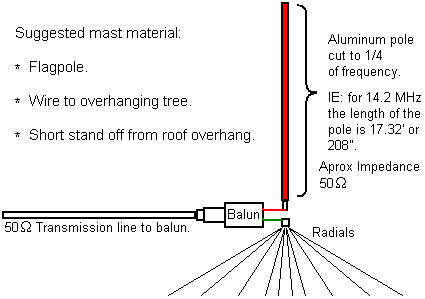Author: Frederick R. Vobbe, W8HDU
May 20, 2009
| 20 meter Vertical w/ Balun Author: Frederick R. Vobbe, W8HDU May 20, 2009 |
 This is a very simple antenna to build. This is a very simple antenna to build.
This started out being a stelth antenna for a friend. He loved working 20 meters, but the housing community he moved into prohibited antennas that could be seen by the public. However, they did not prohibit a flagpole to show off the colors. This was our in! The flagpole kit came from Lowes and cost $29.95. It consisted of four sections of aluminum pipe, a top piece (with pulley), and rope. The only modification I had to make on the flagpole was to change the pulley from a brass pulley to a plastic pulley. This was to keep the pulley from being electrically connected to the flagpole pipe. After all the pipes were connected, we did place a screw through the sections to hold them tight. The instructions of the assembly of the antenna say to slip one section over another, but the fear was that just the pressure of pushing sections together would not be satisfactory for an RF connection. The flagpole was mounted on a PVC post that we placed in the ground. This was accomplisted by using a rotor post-hole digger, and making a 6" wide by 3' deep hole. On the top of the ground, over the hole, we built a 12" x 12" form out of 2 x 8 timber. A 2" piece of PVC pipe was placed in the hole, with a piece of rebar inside the pipe. Then we filled the pipe (trying to center the rebar), and the hole, to to the top of the form. What we ended up with was a PVC post sticking out of the ground about 24" that had rebar and cement inside, and a nice platform for the flagpole made of cement. Before putting the bottom tube on the PVC, we slit the pipe vertically for about 2", and installed a hose clamp. This helped support the flagpole, and allowed an electrical connection to the flagpole. The bottom tube was slipped over the PVC, and clamped down for now. Next, using all sorts of wire that we gathered, a ground system was installed. This consisted of 32 wires, which consisted of telephone drop cable to #18 machine wire. They were cut to about 25 feet in length. You DON'T have to do a lot of digging to install radials. A flat spade pushed down about 2", and wiggled to form a "V" will allow you to push a wire just below the grass line. Install all the radials in as many directions as possible, with the ends coming up near the cement pad. If the flagpole is cut to the proper wavelength, then it should aproximate a 50-ohm load. For 20 meters this would be just under 20 feet. A 35 foot pole should work well for 40 meters. The Balun
The hardest part in making the balun is getting the 14 turns of wire wound around the core, equally spaced, while keeping track of of which wire is which. YES, it is important.
The coax is tied to the bottom input connector. This is an SO-259. The ground screw goes to the radials, and the top screw "Antenna" goes to the flagpole. When cutting the pole for length, it's always best to make it a little long and then trim back the flagpole to correct resonence. It took us three times to get it close to frequency, but we managed. When the balun was installed, it matched up < 1.270 : 1 on all frequencys in 20 meters. Again, keep in mind that match does not translate to good radiation pattern, so after adjusting the antenna for match, make sure it radiates well. It also allowed us to operate some other bands at reduced power and a slightly higher SWR.
The big thing is that NOBODY in his community part is aware he's a ham, and he's flying The Stars and Stripes! It's a wonderful sight. Two warnings: First is that when you are transmitting the flagpole is HOT. Keep that in mind that if someone touches the flagpole, or fido decides to salute it, that there is a shock hazzard. Also, we found out after a rain storm that when a wet flag touched the flagpole, there would be some changes in impedance. Typically the match would shift to the lower side. For example, at 14.3 the match was 1.3 : 1 but when the flag was wet the match went up on 14.3 and the 1.3 : 1 shifted down to 14.270. Meanwhile the 1.16 on 14.1 shifted down to 14.0. Keep this in mind! Till next time, 73. |
 |
© Copyright 2008 All Rights Reserved - W8HDU |